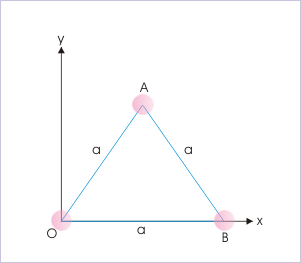| << Chapter < Page | Chapter >> Page > |
On the other hand, torque on the particle is :
But, we know that tangential acceleration is related to angular acceleration as :
Substituting in the expression of torque, we have :
where . Its unit is
Problem : A particle of mass 0.1 kg is attached to one end of a light rod of length 1 m. The rod is hinged at the other end and rotates in a plane perpendicular to the axis of rotation. If the angular speed of the particle is 60 rpm, find the constant torque that can stop the rotation of the particle in one minute.
Solution : The idea here is to apply Newton's second law of rotation for a particle. For this, we need to find angular deceleration. For this, we first convert angular velocity in rad/s :
Since torque "τ" is constant as given in the question, this is obviously the case of uniform deceleration. As such, we can apply equation of rotational motion for constant acceleration,
Here,
Putting values in the equation of motion, we have :
Now, applying Newton's second law of motion for rotation,
Here,
Dropping the sign of deceleration and putting values in the expression of torque, we have the magnitude of torque :
Moment of inertia of a particle about fixed axis is given by :
The moment of inertia of the system of discrete particles is equal to the sum of moments of inertia of individual particles,
where " " is the mass of "i" th particle at perpendicular linear distance " " from the axis of rotation.
Problem : Three particles each of mass "m" are situated at the vertices of an equilateral triangle OAB of length "a" as shown in the figure. Calculate moment of inertia (i) about an axis passing through "O" and perpendicular to the plane of triangle (ii) about axis Ox and (iii) about axis Oy.
Moment of inertia

Solution : We shall make use of the formulae of moment of inertia for discrete particles in each of the cases :
(i) about an axis passing through "O" and perpendicular to the plane of triangle
Here, distances of three particles from the axis are :
The moment of inertia about an axis through "O" and perpendicular to the plane of triangle is :
(ii) about axis Ox
Here distances of three particles from the axis of rotation are :
(iii) about axis Oy
Here distances of three particles from the axes are :
This example illustrates how choice of axis changes moment of inertia i.e. the inertia of the system of particles to rotation. This is expected as change in the reference axis actually changes distribution of mass about axis of rotation.
Rigid body is a continuous aggregation of particles. We, therefore, need to modify the summation in the expression of moment of inertia by integration as :

Notification Switch
Would you like to follow the 'Physics for k-12' conversation and receive update notifications?